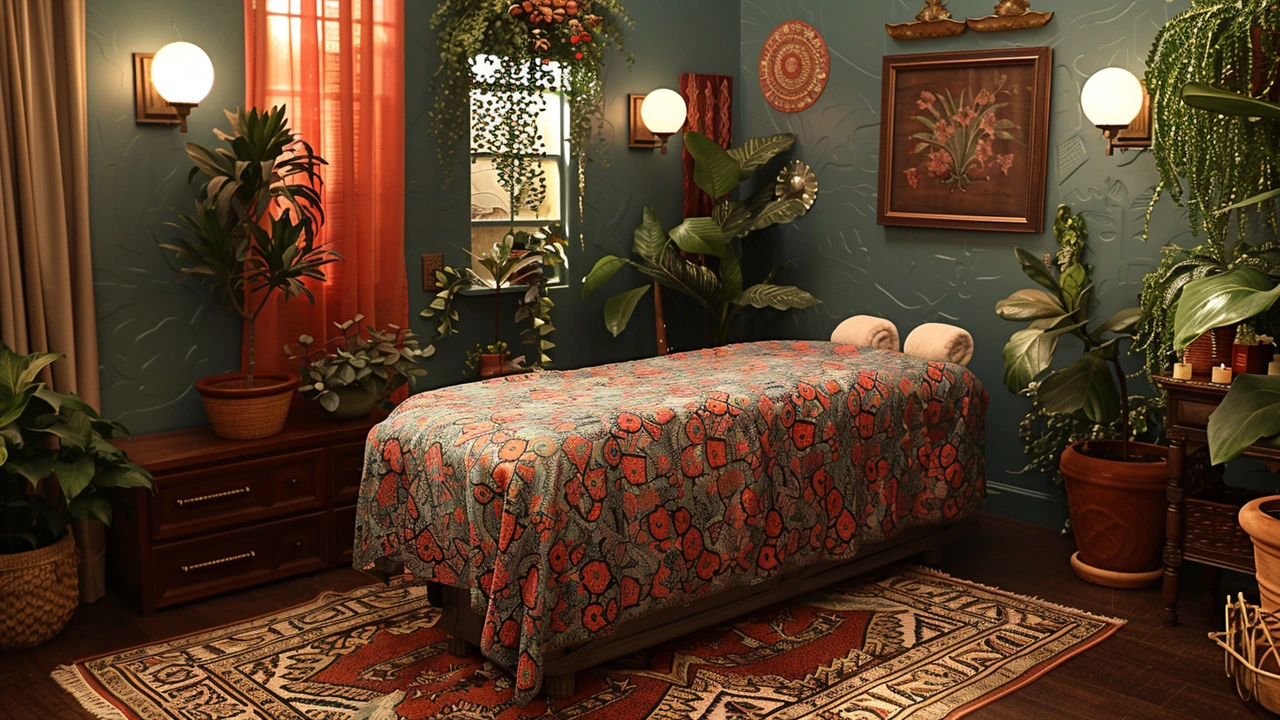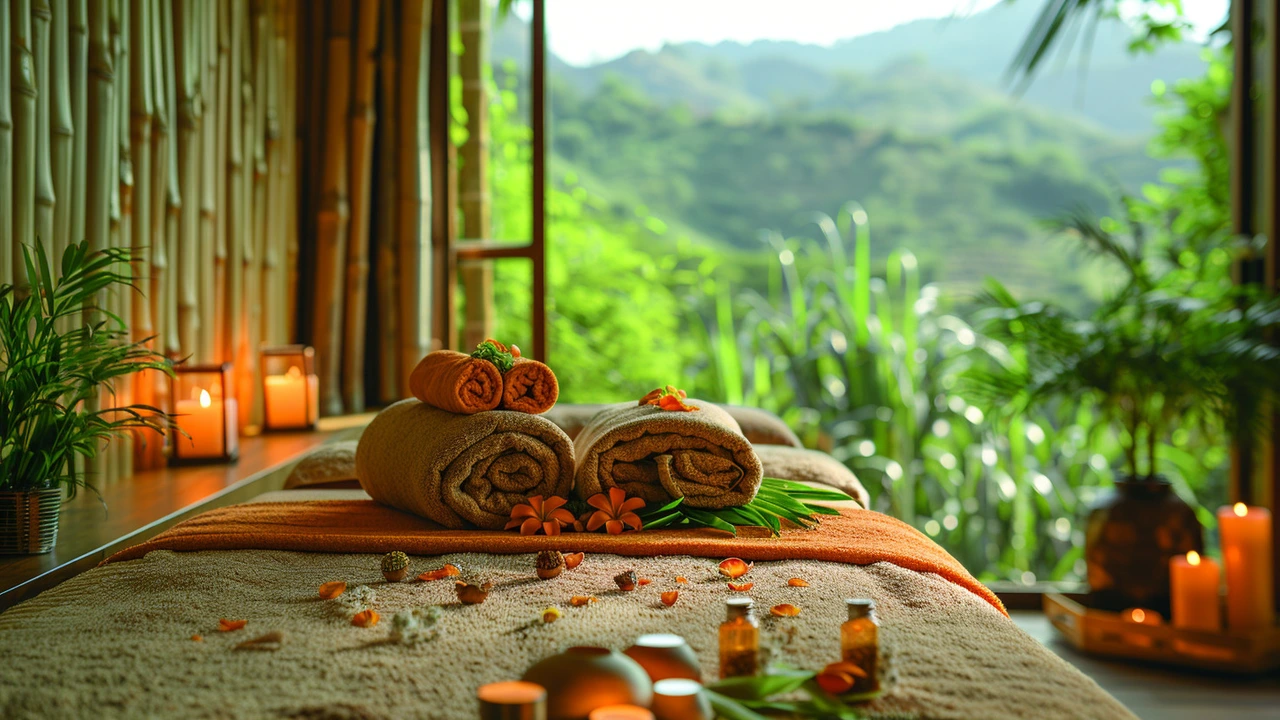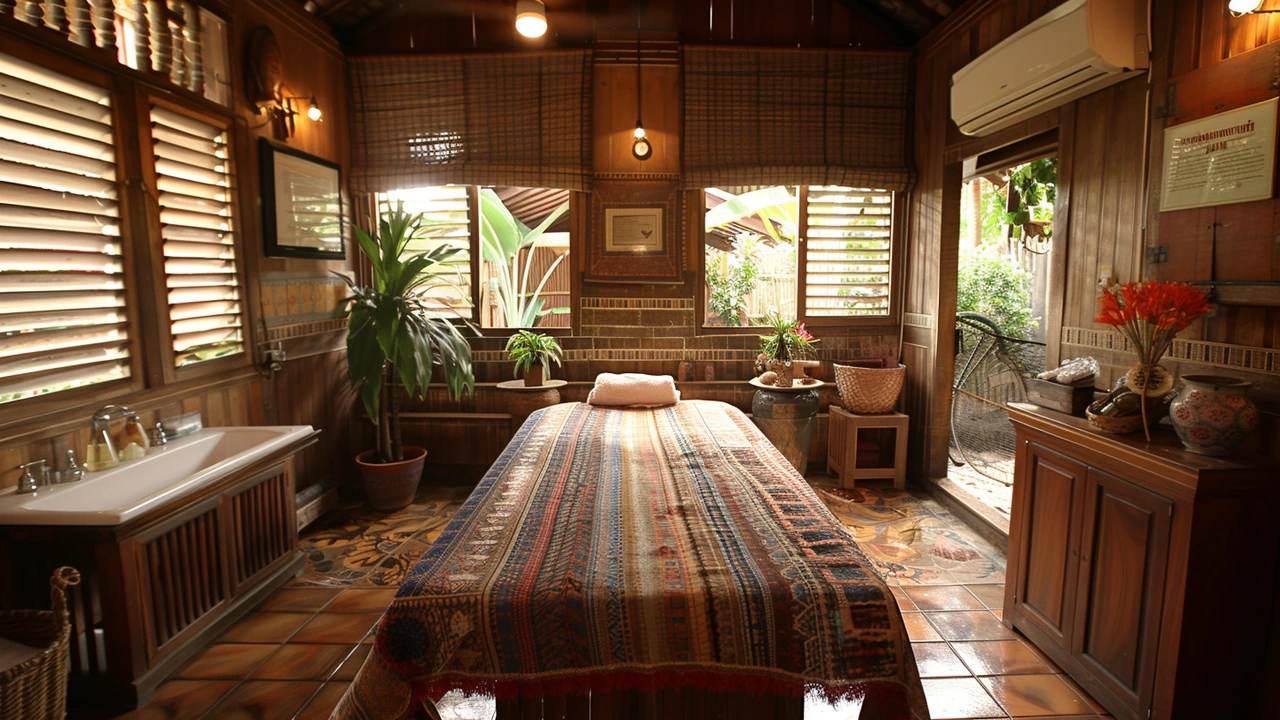Laos, a timeless land tucked away in Southeast Asia, boasts a rich tapestry of healing traditions. Among its many treasures is the art of Laos massage, an ancient practice that has evolved over centuries to offer unmatched relaxation and therapeutic benefits.
With its roots deeply embedded in the country's culture, Laos massage is more than just a physical treatment. It’s a holistic experience that harmonizes the body, mind, and spirit. Drawing from the natural elements and traditional techniques, this unique therapy has started to gain worldwide recognition for its ability to provide profound healing.
In this guide, we’ll explore the essence of Laos massage, from its historical origins to the specific techniques and benefits it offers. We’ll also share insider tips on how to have the most authentic experience, and reveal the best spots in Laos to immerse yourself in this extraordinary practice.
- History of Laos Massage
- Traditional Techniques
- Health Benefits
- Local Ingredients and Tools
- Tips for an Authentic Experience
- Where to Find the Best Laos Massage
History of Laos Massage
The story of Laos massage dates back centuries, rooted deeply in the traditional practices of the Laotian people. This exceptional form of therapy developed as an integral part of the local culture, influenced by both spiritual beliefs and practical wisdom. Originally practiced by monks as a way to maintain physical and spiritual balance, Laos massage has evolved to serve various aspects of health and wellness.
Laos massage, often intertwined with the practices of nearby regions like Thailand and Cambodia, has its own distinctive flair. While it incorporates some elements of Thai massage, such as acupressure and deep-tissue manipulation, it uniquely integrates local herbs and oils that are indigenous to the lush landscapes of Laos. The Laotians believe that these natural elements embody the healing energies of their environment, which are essential for true recovery and relaxation.
Historically, this massage technique was passed down through generations, with knowledge being shared within families and communities. Local healers, often revered figures in their villages, played an essential role in preserving the traditional methods. They treated a range of conditions from physical ailments to mental stress, providing a holistic approach to health care that modern science is beginning to appreciate.
With the advent of modern tourism, the practice of Laos massage has become more widely recognized. Tourists seeking authentic and cultural experiences find themselves drawn to the traditional healing methods of Laos. The availability of these services in reputable spas and wellness centers throughout the country has helped to spread the knowledge and appreciation of this ancient art form beyond its borders.
According to Dr. Phaeng Dao, a noted Laotian ethnobotanist, "The true essence of Laos massage is about balance – balancing the energies within one's body with the natural energies of our surroundings."
Today, Laos massage is celebrated not just for its therapeutic benefits but also as a cultural treasure. It's a living tradition that continues to adapt and thrive, merging ancient wisdom with contemporary wellness practices. This enduring popularity speaks to its efficacy and the deep-seated need for natural, holistic approaches to health and well-being.
Traditional Techniques
Laos massage is a harmonious blend of ancient traditions and local wisdom, handed down through generations. The techniques used are designed not only to relax the body but also to stimulate energy flow and promote natural healing. This synergy of movements and mindfulness makes Laos massage distinct and deeply effective.
The cornerstone of Laos massage lies in its rhythmic compression and gentle rocking motions. Practitioners often start with soothing strokes that calm the mind before moving into slower, more deliberate movements. This rhythm, akin to a dance, helps to unlock energy pathways, allowing for better circulation and a profound sense of well-being.
One of the unique elements of Laos massage is the use of acupressure. Drawing from traditional Chinese medicine, therapists apply pressure to specific points on the body to relieve tension and stimulate energy flow. These acupressure points correspond to various parts of the body and can aid in alleviating pain, improving digestion, and enhancing overall health.
In addition to acupressure, stretching is an integral component of Laos massage. Inspired by the principles of yoga, these stretches help to improve flexibility, release muscle tension, and increase body awareness. The therapist will guide you through gentle stretches, assisting with movements that you might not be able to achieve on your own.
Herbal elements also play a key role in Laos massage. Herbal compresses, made from a blend of local herbs and plants, are warmed and pressed onto the body. These compresses not only provide therapeutic warmth but also infuse the skin with the healing properties of the herbs. Ingredients like lemongrass, turmeric, and camphor are commonly used for their soothing and anti-inflammatory effects.
A distinctive feature of Laos massage is its focus on the Hara, the body's center of gravity located in the lower abdomen. By concentrating on the Hara, therapists believe they can balance the body's energy and improve emotional harmony. This focus on the core is a fundamental aspect that sets Laos massage apart from other modalities.
"The art of touch in Laos massage goes beyond physical comfort; it is about connecting with the essence of life," says Somboun Norasing, a respected massage therapist and healer from Luang Prabang.
Whether using hands, elbows, knees, or feet, the goal of a Laos massage therapist is to create a seamless flow of energy that revitalizes both the body and the mind. The combination of these traditional techniques ensures not only a deeply relaxing experience but also a therapeutic journey that fosters healing and balance.
If you ever find yourself enveloped in the tranquil ambiance of a Laos spa, allow yourself to fully embrace these age-old techniques. The restorative power of a Laos massage is something everyone should experience at least once in their lifetime.

Health Benefits
Laos massage is not just about relaxation; it delivers a multitude of health benefits, making it a sought-after therapeutic practice across the globe. One of the primary advantages is its ability to alleviate stress and anxiety. By employing slow, rhythmic strokes and applying pressure on specific points, Laos massage triggers the release of endorphins, the body's natural feel-good hormones. This can significantly decrease stress levels, creating a calm and serene state of mind.
Another remarkable benefit is pain relief. The techniques used in Laos massage target deep tissues and muscles, helping to relieve chronic pain conditions like arthritis, fibromyalgia, and migraines. Regular sessions can provide long-lasting relief and improve the quality of life for individuals suffering from these ailments. Studies have shown that massage therapy can reduce pain intensity by up to 50%, offering a natural alternative to pain medication.
Additionally, Laos massage promotes better circulation. Improved blood flow not only helps in delivering more oxygen and nutrients to the cells but also aids in the removal of toxins from the body. This boost in circulation can enhance overall health, boost energy levels, and improve the function of vital organs. Enhanced circulation also contributes to better skin health, giving you a natural, radiant glow.
Immune system enhancement is another significant benefit. Regular massages have been found to increase the activity of white blood cells, which play a crucial role in defending the body against illnesses. A study published in the Journal of Alternative and Complementary Medicine concluded that massage therapy can boost the immune system by increasing the body's natural
Local Ingredients and Tools
The magic of Laos massage lies not just in the skilled hands of its practitioners but also in the unique local ingredients and tools they use. One of the hallmarks of this traditional therapy is its incorporation of natural elements sourced directly from the lush, biodiverse environment of Laos.
Among the most commonly used ingredients are various herbs and plants native to the region. For instance, lemongrass is frequently utilized for its invigorating and antiseptic properties. Lemongrass oil is often infused into massage oils, adding a refreshing aroma and therapeutic benefits. Another staple is the plai root, a relative of ginger, known for its anti-inflammatory and pain-relieving attributes. This root is frequently used in herbal compresses, which are warmed and applied to the body to ease muscles and stimulate circulation.
Herbal compresses are a significant aspect of Laos massage. These compresses, known locally as

Tips for an Authentic Experience
Experiencing a Laos massage in its most authentic form necessitates a few thoughtful considerations. To begin with, it's vital to do a bit of research on where you're planning to go. Traditional Laos massage parlors, often known as 'Wat', offer the most genuine and deep-rooted techniques. Unlike commercial spas, these parlors have practitioners who have typically learned their craft from their ancestors, ensuring an undiluted practice.
One useful tip is to ask locals for recommendations. Word of mouth is powerful in Laos, and locals often know the best spots that might not be listed in travel guides. Engaging with the community can lead you to hidden gems where you might even get to watch the technique being explained and performed.
Timing is another essential aspect to consider. The best time to go for a massage is in the morning or late afternoon. The morning sessions help set a calm tone for the day, while late afternoon sessions help recuperate after a day of exploration. Plus, these timings can offer a cooler, more comfortable experience, especially given the hot climate in Laos.
When preparing for your session, wear loose and comfortable clothing. Traditional Laos massage often incorporates a lot of stretching and body movement. Tight or restrictive clothing could hinder the practitioner's ability to perform the techniques effectively. Moreover, some parlors might provide traditional garments to wear during the massage. These garments not only preserve modesty but also add an authentic touch to the experience.
Don't hesitate to communicate with your therapist. Let them know if you have any specific areas that need attention or if any technique feels too intense. Laos practitioners are highly skilled and generally very responsive to their client's needs, and your feedback will help them tailor the massage to suit you best.
If you're aiming for a more immersive experience, consider learning a few basic phrases in Lao. A simple 'Sabaidee' (hello) or 'Khop chai' (thank you) can go a long way in building rapport and showing appreciation for the therapist's skills. Additionally, understanding basic etiquette, such as removing shoes before entering the parlor and offering respectful gestures of thanks, can enhance your overall experience.
Lastly, remember to stay hydrated. Traditional Laos massage often targets deep tissue and can stimulate the lymphatic system, potentially leading to dehydration. Drinking water before and after your session will help keep you hydrated and support the detoxifying effects of the massage.
Embracing these tips can ensure your Laos massage experience is not only physically rejuvenating but also culturally enriching. As Dr. Somchai, a renowned expert in traditional Southeast Asian therapies, puts it:
“A true Laos massage is a journey—one that takes you through the rich heritage and timeless wisdom of the region. It's about more than just relaxation; it's about connecting with the soul of Laos culture.”
Where to Find the Best Laos Massage
If you're looking to experience the magic of Laos massage, you'll be pleased to know that there are several exceptional places in Laos where you can indulge in this therapeutic art. From serene spas nestled in lush environments to bustling massage parlors in the heart of the city, Laos offers a variety of options suited to different preferences.
One of the most renowned places for an authentic Laos massage is the tranquil town of Luang Prabang. This UNESCO World Heritage site is not just famous for its stunning temples and French colonial architecture but also for its wellness offerings. Many spas in Luang Prabang provide traditional massage therapies using local herbs and oils. Places like the Lani Massage and The Spa at Kiridara are known for their skilled therapists and serene settings, ensuring a deeply rejuvenating experience.
"Luang Prabang is a sanctuary for those seeking peace and holistic health. The massages here are not just treatments, they're a journey," says wellness expert Sarah Langfield.
Another destination to explore is Vientiane, the capital city. While it may have a more urban feel, Vientiane boasts some exquisite spa facilities that offer top-notch Laos massage. You can head to the Champa Spa or Herbal Spa to enjoy a blend of traditional and modern healing techniques. These places are known for their warm ambiance and expert practitioners who make sure every knot and tension in your body is eased out.
For those who are traveling to the southern part of Laos, Pakse provides an equally compelling experience. Being a gateway to the Bolaven Plateau, an area famous for its coffee plantations and waterfalls, Pakse offers a range of wellness centers where you can find quality Laos massage. A visit to the Champasak Spa will provide an ideal combination of traditional Laos massage techniques amid breathtaking natural beauty.
In each of these locations, it’s not just about the technique but also about the environment. Staying attuned to nature, many spas incorporate elements like bamboo, water features, and natural light to enhance the feeling of tranquility. The combination of skilled hands and a serene atmosphere work in harmony to deliver an experience that heals not just the body but also the mind and spirit.
If you venture a bit off the beaten path, smaller towns such as Vang Vieng also offer traditional Laos massages that are just as effective and oftentimes more affordable. These local spots offer a more rustic charm, giving you an intimate insight into the cultural essence of Laos massage practices.
Lastly, when selecting a place to get a Laos massage, consider the reviews and recommendations from other travelers and locals. Many visitors share their experiences and ratings on travel forums and websites, which can be very helpful in finding the best places. So whether you're lounging on the banks of the Mekong or exploring the waterfalls of Bolaven Plateau, you can easily find a spot to rejuvenate with an authentic Laos massage.

